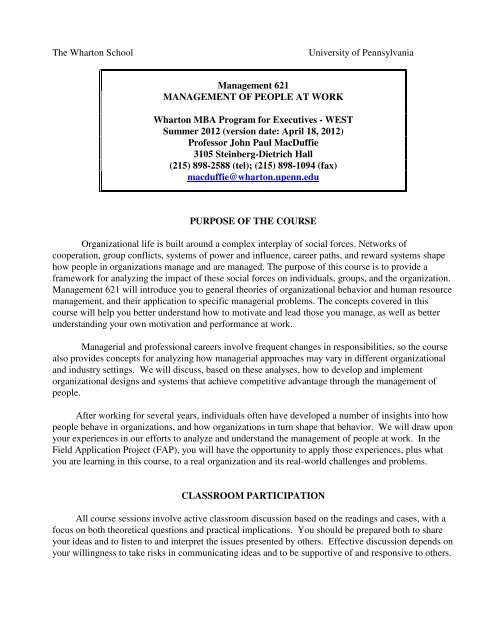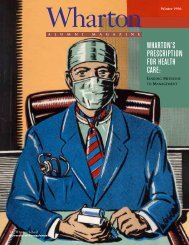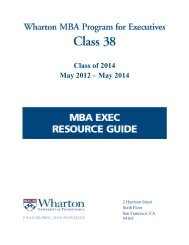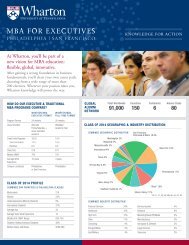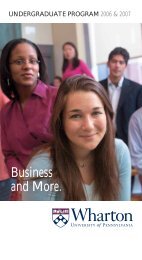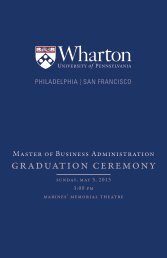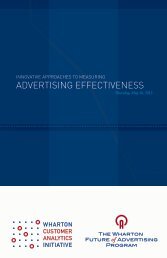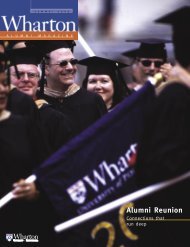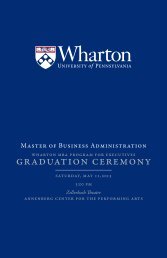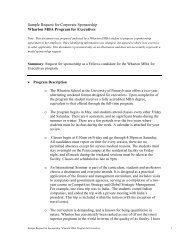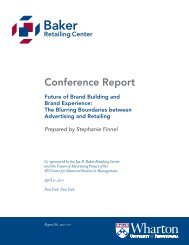version Date: April - The Wharton School of the University of ...
version Date: April - The Wharton School of the University of ...
version Date: April - The Wharton School of the University of ...
Create successful ePaper yourself
Turn your PDF publications into a flip-book with our unique Google optimized e-Paper software.
<strong>The</strong> <strong>Wharton</strong> <strong>School</strong><br />
<strong>University</strong> <strong>of</strong> Pennsylvania<br />
Management 621<br />
MANAGEMENT OF PEOPLE AT WORK<br />
<strong>Wharton</strong> MBA Program for Executives - WEST<br />
Summer 2012 (<strong>version</strong> date: <strong>April</strong> 18, 2012)<br />
Pr<strong>of</strong>essor John Paul MacDuffie<br />
3105 Steinberg-Dietrich Hall<br />
(215) 898-2588 (tel); (215) 898-1094 (fax)<br />
macduffie@wharton.upenn.edu<br />
PURPOSE OF THE COURSE<br />
Organizational life is built around a complex interplay <strong>of</strong> social forces. Networks <strong>of</strong><br />
cooperation, group conflicts, systems <strong>of</strong> power and influence, career paths, and reward systems shape<br />
how people in organizations manage and are managed. <strong>The</strong> purpose <strong>of</strong> this course is to provide a<br />
framework for analyzing <strong>the</strong> impact <strong>of</strong> <strong>the</strong>se social forces on individuals, groups, and <strong>the</strong> organization.<br />
Management 621 will introduce you to general <strong>the</strong>ories <strong>of</strong> organizational behavior and human resource<br />
management, and <strong>the</strong>ir application to specific managerial problems. <strong>The</strong> concepts covered in this<br />
course will help you better understand how to motivate and lead those you manage, as well as better<br />
understanding your own motivation and performance at work.<br />
Managerial and pr<strong>of</strong>essional careers involve frequent changes in responsibilities, so <strong>the</strong> course<br />
also provides concepts for analyzing how managerial approaches may vary in different organizational<br />
and industry settings. We will discuss, based on <strong>the</strong>se analyses, how to develop and implement<br />
organizational designs and systems that achieve competitive advantage through <strong>the</strong> management <strong>of</strong><br />
people.<br />
After working for several years, individuals <strong>of</strong>ten have developed a number <strong>of</strong> insights into how<br />
people behave in organizations, and how organizations in turn shape that behavior. We will draw upon<br />
your experiences in our efforts to analyze and understand <strong>the</strong> management <strong>of</strong> people at work. In <strong>the</strong><br />
Field Application Project (FAP), you will have <strong>the</strong> opportunity to apply those experiences, plus what<br />
you are learning in this course, to a real organization and its real-world challenges and problems.<br />
CLASSROOM PARTICIPATION<br />
All course sessions involve active classroom discussion based on <strong>the</strong> readings and cases, with a<br />
focus on both <strong>the</strong>oretical questions and practical implications. You should be prepared both to share<br />
your ideas and to listen to and interpret <strong>the</strong> issues presented by o<strong>the</strong>rs. Effective discussion depends on<br />
your willingness to take risks in communicating ideas and to be supportive <strong>of</strong> and responsive to o<strong>the</strong>rs.
Management 621 <strong>The</strong> <strong>Wharton</strong> <strong>School</strong>, <strong>University</strong> <strong>of</strong> Pennsylvania MBAExec (West) – Summer 2012<br />
Regular participation in discussions is expected, and you should carefully prepare <strong>the</strong> readings<br />
and cases for every class session. Individuals are called upon from time to time, but most participation<br />
is voluntary. Name cards must be consistently displayed during class, and it is essential that you attend<br />
all course meetings. Participation counts for 20% <strong>of</strong> your course grade; 15% for individual<br />
participation in class discussion and 5% for your team’s case presentation (see below).<br />
In preparing cases for discussion in class, be ready to comment on (1) <strong>the</strong> case’s background and<br />
context; (2) <strong>the</strong> key issues and problems; (3) concepts useful for analyzing <strong>the</strong> issues and problems;<br />
and (4) a course <strong>of</strong> action for designing and implementing solutions. Questions specific to each case<br />
have been provided in this syllabus to help guide your preparation; however I encourage you to go<br />
beyond <strong>the</strong>se questions in thinking about how to apply any course concepts that are relevant to <strong>the</strong> case.<br />
LEARNING TEAMS AND CASE PRESENTATIONS<br />
Learning teams are integral to <strong>the</strong> work <strong>of</strong> Management 621. Several activities are conducted<br />
through <strong>the</strong> teams, and you may find that preparing for class is facilitated by team discussion. All<br />
participants will be assigned to a learning team by <strong>the</strong> MBAExec program; team assignment is based<br />
on diversity <strong>of</strong> background and experience, subject to physical location constraints.<br />
Each team is assigned to analyze <strong>the</strong> case and readings for one class session. Teams will be<br />
assigned to cases during <strong>the</strong> first week <strong>of</strong> classes. This analysis should explore connections within <strong>the</strong><br />
assigned materials (i.e. how do <strong>the</strong> readings relate to <strong>the</strong> case and vice-versa) and beyond <strong>the</strong> material<br />
to o<strong>the</strong>r experiences, examples, and ways <strong>of</strong> communicating key concepts or insights (i.e. How do <strong>the</strong><br />
readings and/or case relate to <strong>the</strong> past and present experiences <strong>of</strong> any member <strong>of</strong> <strong>the</strong> team Can you<br />
think <strong>of</strong> related and relevant examples from <strong>the</strong> business world, ei<strong>the</strong>r past or present Can you<br />
identify a resource that helps make an important point related to this particular class, e.g. a video, a<br />
song, an image, a literary reference)<br />
<strong>The</strong> assignment requires that you convey your analysis to me and your classmates in two ways:<br />
1. Team paper -- 4-5 pages double-spaced, sent to me by 5 pm on <strong>the</strong> day before <strong>the</strong> class to<br />
which you are assigned<br />
2. Team presentation -- 10 minutes in class in which you present <strong>the</strong> key points from your paper<br />
in a clear, well-organized, compelling, and (if you wish) creative way<br />
This team assignment is worth 5% towards <strong>the</strong> 20% participation grade; as noted above, <strong>the</strong><br />
remaining 15% <strong>of</strong> <strong>the</strong> grade is based on individual participation.<br />
For this team paper, I want <strong>the</strong> members <strong>of</strong> your team to dig into <strong>the</strong> readings and case:<br />
• What intrigues you<br />
• What’s thought-provoking<br />
• What’s important<br />
• What don’t you quite buy, if anything<br />
• What do you think <strong>the</strong> class should note in particular about <strong>the</strong> link between reading and case<br />
• What issues do you think <strong>the</strong> class should grapple with<br />
2
Management 621 <strong>The</strong> <strong>Wharton</strong> <strong>School</strong>, <strong>University</strong> <strong>of</strong> Pennsylvania MBAExec (West) – Summer 2012<br />
I’m looking for thoughtful commentary that reflects your team’s discussions <strong>of</strong> <strong>the</strong> assigned material –<br />
not a summary <strong>of</strong> ei<strong>the</strong>r <strong>the</strong> case or <strong>the</strong> readings and not one person’s solo effort on behalf <strong>of</strong> <strong>the</strong> team.<br />
Do be personal, thoughtful, and analytical. It is fine, and desirable, to use <strong>the</strong> word “we.” Do<br />
suggest video clips, songs, newspaper or business media stories, images, literary references etc. that<br />
help illustrate <strong>the</strong> points you want to make. When I learn about a particularly helpful resource that is<br />
suggested by a team, I will provide access to it (i.e. distribute a copy, post a link, show/play it in class).<br />
For <strong>the</strong> presentation, you have 10 minutes to convey what was included in your paper. (I will run<br />
a timer and cut you <strong>of</strong>f when 10 minutes is up.) You may choose from a variety <strong>of</strong> formats. A<br />
Powerpoint presentation is fine; more than one person should be involved in <strong>the</strong> presentation but<br />
<strong>the</strong>re’s no need for all team members to present. You may also set up a “point and counterpoint”<br />
discussion/debate; dramatize something from <strong>the</strong> case; demonstrate points through a role play; show<br />
different possible future scenarios based on what might happen beyond <strong>the</strong> case; and <strong>the</strong>re are many<br />
o<strong>the</strong>r possibilities. If you have any questions about whe<strong>the</strong>r what you are planning will meet my<br />
expectations and/or my goals for what is learned during <strong>the</strong> class, please ask.<br />
COURSE READINGS<br />
This is a reading-intensive course. All readings are contained in a coursepack, which will be<br />
available on Study.net. You will also receive various handouts throughout <strong>the</strong> course, both in class and<br />
posted on <strong>the</strong> courseware website, Canvas.<br />
SPECIAL TOPIC (NOMINATED BY STUDENTS)<br />
In recent years, I have asked students to suggest a topic related to <strong>the</strong> course that <strong>the</strong>y find to be<br />
important in <strong>the</strong>ir jobs/organizations and want to understand better. We <strong>the</strong>n devote a class session to<br />
this special topic, this year scheduled for Friday, August 3 rd . <strong>The</strong> nomination process begins during <strong>the</strong><br />
first week <strong>of</strong> classes, as a discussion topic on Canvas. I consolidate <strong>the</strong> suggestions into a short list <strong>of</strong><br />
topics and put <strong>the</strong>m to <strong>the</strong> class for a vote. I <strong>the</strong>n develop a supplement to <strong>the</strong> syllabus with readings, a<br />
case, and study questions. <strong>The</strong> special topic in 2010 was Organizational Design and Structure; in 2011,<br />
it was Compensation Within Organizations.<br />
COURSE FEEDBACK CIRCLE<br />
A single feedback circle is formed with three volunteers from each section to review and guide<br />
<strong>the</strong> course work. I will establish <strong>the</strong> schedule <strong>of</strong> meetings during <strong>the</strong> first week <strong>of</strong> class.<br />
“FEET WET”: FIRST WEEK WRITING ASSIGNMENT<br />
I added this assignment after requests to provide some early feedback on your writing and<br />
whe<strong>the</strong>r you are grasping <strong>the</strong> approach to analytical writing I’m seeking in this course. <strong>The</strong> basic idea<br />
is to show that you can link course content (e.g. <strong>the</strong>ories) to a case example (e.g. a specific situation). I<br />
3
Management 621 <strong>The</strong> <strong>Wharton</strong> <strong>School</strong>, <strong>University</strong> <strong>of</strong> Pennsylvania MBAExec (West) – Summer 2012<br />
plan to return <strong>the</strong>se one-page papers with comments but no grade -- just check, check-plus, checkminus<br />
-- and no role in <strong>the</strong> ultimate grading process. This assignment is due in class on Thursday,<br />
May 24; I’ll provide <strong>the</strong> assignment details on Day 1. I’ll also explain o<strong>the</strong>r opportunities for writing<br />
feedback in this course.<br />
COURSE PAPER #1: ANALYSIS OF YOUR CURRENT (OR PREVIOUS) JOB<br />
<strong>The</strong> first graded individual assignment is to analyze your current job (or a previous job) using<br />
course concepts. More precisely, you should use your job as <strong>the</strong> “case” that allows you to apply and<br />
demonstrate your knowledge <strong>of</strong> <strong>the</strong> course material. You may explore such issues as motivation, job<br />
design, reward systems, managing individual and group performance, and group influences on<br />
decision-making. <strong>The</strong> choice about what issues to cover and what concepts to apply is yours. In<br />
evaluating your paper, we will look to see whe<strong>the</strong>r <strong>the</strong> concepts you use are described accurately (i.e.<br />
substantively correct), applied appropriately (i.e. fit <strong>the</strong> job situation you describe), and most relevant<br />
to <strong>the</strong> situation (i.e. did you pick <strong>the</strong> concepts that best illuminates your job situation). This paper will<br />
count for 20% <strong>of</strong> your course grade.<br />
In analyzing your job, focus on how you were managed, not how you behaved in managing<br />
o<strong>the</strong>rs. It does not matter whe<strong>the</strong>r you had a good job experience or a bad job experience. You can<br />
talk about both <strong>the</strong> successful and <strong>the</strong> unsuccessful aspects <strong>of</strong> <strong>the</strong> job, and about what was missing for<br />
you. Very good papers will provide <strong>the</strong> reader with two things: 1) a sense <strong>of</strong> how <strong>the</strong> various issues fit<br />
toge<strong>the</strong>r analytically, and 2) a clear feeling for what it was really like to have that job.<br />
You need to be explicit in your use <strong>of</strong> <strong>the</strong> course <strong>the</strong>ories/concepts. Very good papers do not<br />
simply present a lively and detailed description <strong>of</strong> your past job. Ra<strong>the</strong>r, <strong>the</strong>y demonstrate in-depth<br />
understanding and application <strong>of</strong> course concepts and <strong>the</strong>ories.<br />
Here’s my guidance on how many concepts/<strong>the</strong>ories you should use. More <strong>the</strong>ories can be<br />
better, because you can analyze more aspects <strong>of</strong> your job plus demonstrate more knowledge <strong>of</strong> course<br />
material. Thus a paper that uses more <strong>the</strong>ories and does so effectively can end up with a higher rank in<br />
<strong>the</strong> relative comparison (which is how we grade <strong>the</strong>se papers). However, <strong>the</strong>re are definitely<br />
diminishing returns if you cover lots <strong>of</strong> <strong>the</strong>ories, all <strong>of</strong> <strong>the</strong>m superficially, since this can make it tough<br />
to see if you actually understand <strong>the</strong>m and how to apply <strong>the</strong>m. Plus you need to provide enough rich<br />
descriptive material about your job so we can understand it. So I ask for a minimum <strong>of</strong> three<br />
concepts/<strong>the</strong>ories. One <strong>the</strong>ory is not enough, six is very likely too many. Within that range, we look<br />
for you making wise choices about <strong>the</strong> concepts and <strong>the</strong>ories that best fit your job situation; extra<br />
<strong>the</strong>ories that don’t really fit won’t help you.<br />
In using multiple concepts and <strong>the</strong>ories, you also have <strong>the</strong> opportunity to explore (and<br />
demonstrate your understanding <strong>of</strong>) <strong>the</strong> similarities, complementarities, or inconsistencies among <strong>the</strong><br />
concepts and <strong>the</strong>ories (i.e., do <strong>the</strong> concepts/<strong>the</strong>ories fit toge<strong>the</strong>r and reinforce each o<strong>the</strong>r or do <strong>the</strong>y<br />
disagree How do <strong>the</strong>y complement each o<strong>the</strong>r Conversely, how are <strong>the</strong>y inconsistent or<br />
conflicting). This is not required but is something you can consider doing to streng<strong>the</strong>n your paper,<br />
assuming that your job situation provides you with <strong>the</strong> raw material for this analysis.<br />
Here are a few more words <strong>of</strong> advice based on our past experiences with <strong>the</strong>se papers:<br />
4
Management 621 <strong>The</strong> <strong>Wharton</strong> <strong>School</strong>, <strong>University</strong> <strong>of</strong> Pennsylvania MBAExec (West) – Summer 2012<br />
• Don't forget that this is an exercise that must be graded. It is easy to get carried away with<br />
an interesting story and forget that this is also a way to test your knowledge <strong>of</strong> and ability to<br />
apply <strong>the</strong> course material.<br />
• Be sure to explore your personal experience with your job, ra<strong>the</strong>r than writing generically<br />
about <strong>the</strong> experience <strong>of</strong> all people in positions like yours.<br />
• It may be useful to develop a comparative angle in <strong>the</strong> paper, i.e. compare how your job<br />
experience varied for two different tasks or compare your job before and after a change in<br />
your boss or a company restructuring.<br />
• Remember to mention course <strong>the</strong>ories specifically, so we don’t have to read your mind to<br />
figure out what concepts you are applying to your work experience. Drawing explicit links<br />
between <strong>the</strong> concepts you identify and <strong>the</strong> case material is <strong>the</strong> key. Don't just drop in <strong>the</strong><br />
names <strong>of</strong> a few <strong>the</strong>ories or concepts into <strong>the</strong> midst <strong>of</strong> describing your job. Show how <strong>the</strong>y<br />
apply to your situation.<br />
• Don't simply focus on your favorite issue, or spend a lot <strong>of</strong> time on issues that aren't<br />
relevant to this course.<br />
<strong>The</strong> paper should have a normal font and be double-spaced. <strong>The</strong> maximum length is 1,250 words,<br />
plus or minus 5%. Please include a word count on <strong>the</strong> front page. You will have to be concise and make<br />
choices about what issues to discuss. Formal references or footnotes are not necessary for readings in <strong>the</strong><br />
bulkpack, though be sure to identify a <strong>the</strong>ory or an author explicitly in <strong>the</strong> text. This paper is due via<br />
submission to webCafé by <strong>the</strong> end <strong>of</strong> day on Saturday, June 23rd.<br />
COURSE PAPER #2: INDIVIDUAL CASE ANALYSIS<br />
For <strong>the</strong> second individual assignment, I ask you to submit a written analysis <strong>of</strong> a new case, to be<br />
distributed, along with <strong>the</strong> questions to address, roughly a month before <strong>the</strong> paper is due. As with Paper<br />
#1, I will be looking for <strong>the</strong> application <strong>of</strong> course concepts. <strong>The</strong> maximum length for this case analysis is<br />
1,500 words, plus or minus 5%; it should have a normal-sized font and be double-spaced. Please include<br />
a word count on <strong>the</strong> front page. In view <strong>of</strong> <strong>the</strong> word limit, it is not advisable to summarize case data in<br />
<strong>the</strong> report, but to use data selectively to make specific points. <strong>The</strong> grade will be based on <strong>the</strong> quality <strong>of</strong><br />
<strong>the</strong> ideas, <strong>the</strong> appropriateness <strong>of</strong> <strong>the</strong> concepts chosen, and on how convincingly <strong>the</strong> arguments are made.<br />
This case analysis will count for 20% <strong>of</strong> your grade. It is due via submission to webCafé by <strong>the</strong> end <strong>of</strong><br />
day on Wednesday, July 25.<br />
FIELD APPLICATION PROJECT (FAP)<br />
<strong>The</strong> major group assignment for this course is <strong>the</strong> Field Application Project (FAP), carried out<br />
through learning teams. To guide you through this project, I’ve developed a separate FAP Handbook,<br />
which will distributed to you early in <strong>the</strong> course. I also summarize <strong>the</strong> main elements <strong>of</strong> <strong>the</strong> FAP here.<br />
5
Management 621 <strong>The</strong> <strong>Wharton</strong> <strong>School</strong>, <strong>University</strong> <strong>of</strong> Pennsylvania MBAExec (West) – Summer 2012<br />
<strong>The</strong> focus <strong>of</strong> this project is applying concepts and <strong>the</strong>ories from <strong>the</strong> course to real life<br />
organizational problems in an integrative fashion. You will choose which specific problem to work on,<br />
and in which organization. Most teams choose <strong>the</strong> organization <strong>of</strong> one team member as <strong>the</strong> FAP site,<br />
while o<strong>the</strong>r teams find <strong>the</strong>ir FAP sites through o<strong>the</strong>r organizational connections <strong>of</strong> team members (e.g.<br />
a place where someone volunteers; via a family member.)<br />
We will devote certain class sessions to meetings about FAP between <strong>the</strong> instructor and each<br />
learning team. <strong>The</strong> first meeting, roughly 25 minutes per team, is scheduled for Saturday, June 9.<br />
Teams should plan to develop a one-page summary for <strong>the</strong> FAP that includes a statement <strong>of</strong> <strong>the</strong><br />
problem, <strong>the</strong> planned scope <strong>of</strong> work, and a preliminary approach to exploring <strong>the</strong> problem. This onepage<br />
summary should be e-mailed to me by Wednesday, June 6. <strong>The</strong> second meeting is scheduled<br />
for Saturday, July 21. This will be a progress report, again roughly 25 minutes per team. Please<br />
email a written progress report to me by Wednesday, July 18.<br />
<strong>The</strong> final report for FAP is due on <strong>the</strong> last day <strong>of</strong> class, Saturday, August 4. <strong>The</strong> FAP<br />
reports should be 20 pages long, or roughly 5000 words (word count not needed; appendices not<br />
included in page count). A case format can prove quite valuable, organizing <strong>the</strong> report in multiple<br />
parts, e.g. part 1 that focuses on pure description <strong>of</strong> <strong>the</strong> problem or decision situation, part 2 that<br />
provides your team’s analysis <strong>of</strong> <strong>the</strong> problem; and part 3 that provides your team’s recommendations<br />
for action. Fur<strong>the</strong>r guidance on <strong>the</strong> structure <strong>of</strong> <strong>the</strong> project report will be provided during <strong>the</strong> course.<br />
This report will count for 35% <strong>of</strong> your course grade.<br />
Each learning team will also present its work on FAP to <strong>the</strong> class on <strong>the</strong> last day <strong>of</strong> <strong>the</strong> course.<br />
<strong>The</strong> presentation will count for 5% <strong>of</strong> your course grade. In addition to providing an opportunity to<br />
present ideas before a group <strong>of</strong> peers, this also has <strong>the</strong> advantage <strong>of</strong> sharing <strong>the</strong> learning from your<br />
project. While <strong>the</strong> percentage <strong>of</strong> your grade that depends on your FAP presentation is low, <strong>the</strong> implicit<br />
motivation to do well on <strong>the</strong> presentation is high, in my experience, given <strong>the</strong> natural competitiveness<br />
<strong>of</strong> MBAExec students and <strong>the</strong> feeling <strong>of</strong> pride that team members have about <strong>the</strong>ir FAP work. <strong>The</strong><br />
team should prepare a one page summary <strong>of</strong> <strong>the</strong>ir presentation for distribution to <strong>the</strong> class.<br />
By way <strong>of</strong> illustration, some project titles from <strong>the</strong> past several years are:<br />
• Mind <strong>the</strong> Gap: Confronting Generational Myths among Cisco Employees<br />
• Improving Attraction and Retention <strong>of</strong> Certified Registered Nurse Anes<strong>the</strong>tists<br />
• Black Rock-Barclays Global Investors Merger: Morale and Motivation at Black Rock SF<br />
• Oracle: Managing Developers, Developing Managers<br />
• Glengarry GlenSABIC: <strong>The</strong> New Leads Initiative at Saudi Basic Industries<br />
• Sid’s Hardware: Jayworking on Jay Street<br />
• Implementing Cost Savings in <strong>the</strong> Legal Division <strong>of</strong> Bristol-Myers Squibb<br />
• KLA-Tencor Customer Feature Requests: Climbing Out <strong>of</strong> <strong>the</strong> Black Hole<br />
• BOC Edwards: Motivating Employees During Philadelphia Plant Closure<br />
• Retaining New Mo<strong>the</strong>rs in Demanding Jobs: Fox News, Washington Bureau<br />
• Allegiant Travel: Managing Culture in a Growing Company<br />
• <strong>The</strong> Princeton Review: Cracking <strong>the</strong> Acquisition Test<br />
• Engaging Associates in Times <strong>of</strong> Change at Capital One<br />
• Transitioning to Alternative Legal Fee Structures<br />
6
Management 621 <strong>The</strong> <strong>Wharton</strong> <strong>School</strong>, <strong>University</strong> <strong>of</strong> Pennsylvania MBAExec (West) – Summer 2012<br />
• ERisk: One Team, Many ‘I’s’<br />
• Star Wars: Being SMART on Retention<br />
• Red Door Spas: Short-Term Incentives and <strong>The</strong>ir Effects on Employee Motivation<br />
• Electronic Medical Records: A Clinic’s Long Journey<br />
• Protecting Pandora’s Box: Preserving Organizational Culture in Recruiting and<br />
Performance Management<br />
• Polishing <strong>the</strong> GemStone: Aligning Goals and Incentives in a Virtual Workforce<br />
• Swords into Ploughshares: Integrating Military Veterans at Con Edison<br />
• <strong>The</strong> Merger <strong>of</strong> MedCases and IC Axon: A Tale <strong>of</strong> Two Sales Teams<br />
• Viropharma Inc.: Evaluating Organizational Dynamics Amid Rapid Growth<br />
• Deutsche Bank: Managing <strong>the</strong> Risks <strong>of</strong> a Location Optimization Strategy<br />
• How Can Stocklmeir Elementary Motivate and Retain Teachers<br />
• GE’s Financial Management Program: Doing It Better<br />
• <strong>The</strong> Limited Inc.: Redesigning <strong>the</strong> District Manager’s Role<br />
• Air Products: Implementing Diversity at a Mature Multi-National Company<br />
• Retention <strong>of</strong> Good Technology Employees Inside Motorola<br />
• Attracting and Retaining Millenials: <strong>The</strong> Next Generation at Campbell’s<br />
• Transforming Angel.com into a Customer-Centric Organization<br />
• Clone or Die: Genentech’s Struggle to Reinvent Itself<br />
• <strong>The</strong> Roger Smith Hotel: An Organization at a Cultural Crossroad<br />
• Managing A Biotech across Two Continents: Organizational Challenges at Chemizon<br />
• Patient Safety at Swedish Medical Center: A Call to Action<br />
• Pixar <strong>University</strong>: <strong>The</strong> Force Behind Efficient Employee Utilization<br />
• Connecting <strong>the</strong> Links at AirLink<br />
• <strong>The</strong> Differentiated Workforce at Cypress Semiconductor<br />
• Searching for Innovation at Micros<strong>of</strong>t Online Services Division<br />
• Asian Americans for Community Involvement: Enhancing Organizational Efficiency<br />
EVALUATION<br />
Course evaluation is based on written work and classroom participation, including both<br />
individual contributions and group activities, weighted as follows:<br />
Class participation (including team case presentation)<br />
Course paper – analysis <strong>of</strong> your current job<br />
Individual case analysis<br />
Field Application Project -- written report<br />
Field Application Project -- team presentation<br />
20 percent<br />
20 percent<br />
20 percent<br />
35 percent<br />
5 percent<br />
7
Management 621 <strong>The</strong> <strong>Wharton</strong> <strong>School</strong>, <strong>University</strong> <strong>of</strong> Pennsylvania MBAExec (West) – Summer 2012<br />
SUMMARY OF CLASS SESSIONS<br />
MBAExec WEST -- Summer 2012<br />
Day 1, Session A Introduction to Management <strong>of</strong> People at Work Mon., May 21<br />
Day 1, Session B Motivating Individual Performance Mon., May 21<br />
Day 2, Session A Designing Jobs Wed., May 23<br />
Day 2, Session B Designing Reward Systems Wed., May 23<br />
Day 3, Session A, B Understanding Social Identities (w/Peter Kuril<strong>of</strong>f) Thurs., May 24<br />
Day 4, Session A Recruiting and Selecting Employees Fri., June 8<br />
Day 4, Session B Leadership and Individual Performance Fri., June 8<br />
Day 5, Session A, B First Meeting about FAP project Sat., June 9<br />
Day 6, Session A Driving Group Performance Fri., June 22<br />
Day 6, Session B Decision-Making in Groups and Organizations Fri., June 22<br />
Day 7, Session A Organizing for Productivity and Quality Sat., June 23<br />
Day 7, Session B Organizing for Innovation Sat., June 23<br />
Day 8, Session A Managing a Startup Fri., July 20<br />
Day 8, Session B Creating a High-Performance Culture Fri., July 20<br />
Day 9, Session A,B Second Meeting about FAP project Sat., July 21<br />
Day 10, Session A Special Topic: Nominated by Students Fri., August 3<br />
Day 10, Session B Aligning Human Resources and Business Strategy Fri., August 3<br />
Day 11, Session A, B Presentation <strong>of</strong> FAP Project Sat., August 4<br />
SUMMARY OF COURSE ASSIGNMENT DATES<br />
Thurs., May 24 “Feet wet” writing assignment due in class<br />
Wed., June 6 1-page FAP proposal e-mailed to instructor<br />
Sat., June 9 Team meeting #1 with instructor re: FAP<br />
Sat., June 23 Paper analyzing your job submitted via Canvas<br />
Wed., July 18 FAP progress report e-mailed to instructor<br />
Sat., July 21 Team meeting #2 with instructor re: FAP<br />
Wed., July 25 Individual case analysis submitted via Canvas<br />
Sat., August 4 FAP presentation (1 pg.) & FAP report (20 pgs.)<br />
8
Management 621 <strong>The</strong> <strong>Wharton</strong> <strong>School</strong>, <strong>University</strong> <strong>of</strong> Pennsylvania MBAExec (West) – Summer 2012<br />
TOPICS AND READINGS<br />
Day 1, Session A COURSE INTRODUCTION Mon., May 21<br />
Description: We emphasize <strong>the</strong> central goal for <strong>the</strong> course: to provide students with insights into<br />
<strong>the</strong> complexities <strong>of</strong> human behavior at work and in organizations. We describe <strong>the</strong> sequence <strong>of</strong><br />
topics, from <strong>the</strong> individual level (motivation, job design, equity issues) to <strong>the</strong> group level<br />
(stimulating effective group performance, group decision-making) and <strong>the</strong> organizational level<br />
(culture, organizational design, human resource systems and <strong>the</strong> link to business strategy). We also<br />
review course requirements. <strong>The</strong> readings and case will let us consider key issues confronting<br />
managers <strong>of</strong> people at work, now and in <strong>the</strong> past, to look for similarities and differences.<br />
Readings: Selections (mostly from Fast Company: “Engines <strong>of</strong> Democracy: General Electric”<br />
(October 1999); “Free Agents in <strong>the</strong> Olde World” (May 2001); “Miracle <strong>of</strong> Birth” (October 2002);<br />
“<strong>The</strong> Fabric <strong>of</strong> Creativity” (December 2004); “A Prescription for Innovation” (<strong>April</strong> 2006); “No<br />
Satisfaction at Toyota” (December 2006); “<strong>The</strong> Faces and Voices <strong>of</strong> Google” (March 2008);<br />
Interview with Costco CEO Jim Sinegal (November 2008); “How CAA Plans to Liberate Game<br />
Designers” (<strong>April</strong> 2010); “Hey Rock Stars, Take Your Show Somewhere Else” (January 2011; NY<br />
Times); “Would You Like a Smile with That” (August 2011; NY Times); “KAYAK on Creating a<br />
Culture <strong>of</strong> Innovation” (<strong>April</strong> 2012) Note: <strong>The</strong>se can be sampled and skimmed; <strong>the</strong>y introduce<br />
recent developments in <strong>the</strong> world <strong>of</strong> work that we will consider during <strong>the</strong> course.<br />
Case: <strong>The</strong> Rose Company<br />
1. What is <strong>the</strong> nature <strong>of</strong> <strong>the</strong> change in this company<br />
2. How do <strong>the</strong> vice presidents feel about <strong>the</strong> reorganization<br />
3. What should James Pierce do -- and what will he do<br />
Day 1, Session B MOTIVATING INDIVIDUAL PERFORMANCE Mon., May 21<br />
Description: We begin with an obvious truism about human behavior in organizations -- that<br />
people will behave according to what actions <strong>the</strong>y perceive are being rewarded. We <strong>the</strong>n begin our<br />
exploration <strong>of</strong> <strong>the</strong> <strong>the</strong>me “behavior is not that simple” by pointing out how <strong>of</strong>ten organizations<br />
“reward A while hoping for B”. We also introduce various motivation <strong>the</strong>ories from <strong>the</strong> behavioral<br />
sciences and contrast <strong>the</strong>m with more economics-based views <strong>of</strong> motivation (e.g. agency <strong>the</strong>ory)<br />
which emphasize financial incentives and contract-based goal alignment.<br />
Readings: Steven Kerr, “On <strong>the</strong> Folly <strong>of</strong> Rewarding A While Hoping for B,” Academy <strong>of</strong><br />
Management Executive, Vol. 9, No. 1, pp. 7-14, 1994.<br />
Stephen P. Robbins and Timothy A. Judge, excerpts from “Motivation,” Organizational Behavior,<br />
12 th edition, Englewood Cliffs, N.J.: Prentice Hall, 2007, pp. 192-198, 208-210.<br />
Case: Nordstrom Department Store<br />
1. Who sets <strong>the</strong> performance goals, and how are <strong>the</strong>y set<br />
2. What are <strong>the</strong> major positive and negative effects <strong>of</strong> this incentive system<br />
9
Management 621 <strong>The</strong> <strong>Wharton</strong> <strong>School</strong>, <strong>University</strong> <strong>of</strong> Pennsylvania MBAExec (West) – Summer 2012<br />
Day 2, Session A DESIGNING REWARD SYSTEMS Wed., May 23<br />
Description: Here we focus on <strong>the</strong> design <strong>of</strong> reward systems, keeping in mind various cognitive<br />
processes that affect motivation. We introduce concepts from equity <strong>the</strong>ory, which describes how<br />
individuals assess <strong>the</strong> ratio <strong>of</strong> outcomes (pay, recognition) in relation to inputs (<strong>of</strong> effort, skill,<br />
experience) for <strong>the</strong>mselves in comparison with o<strong>the</strong>rs. We <strong>the</strong>n consider <strong>the</strong> actions (and shifts in<br />
perception) individuals may undertake to establish a sense <strong>of</strong> equity. <strong>The</strong> case discussion<br />
emphasizes how <strong>the</strong> compensation and reward system <strong>of</strong> an organization must balance incentive and<br />
equity concerns. We also explore <strong>the</strong> role <strong>of</strong> <strong>the</strong> labor market in constraining <strong>the</strong> kinds <strong>of</strong><br />
compensation systems firms can implement. Please come prepared with examples <strong>of</strong> reward systems<br />
you have encountered and we will discuss <strong>the</strong>m.<br />
Readings: Elliot Aronson, “<strong>The</strong> Rationalizing Animal,” Psychology Today, May 1973, p. 67-77.<br />
Stephen P. Robbins & Timothy A. Judge, “Equity <strong>The</strong>ory,” from Organizational Behavior, 12 th<br />
edition, Englewood Cliffs, N.J.: Prentice Hall, 2007, pp. 203-207.<br />
Case: Brainard, Bennis, and Farrell<br />
1. How should <strong>the</strong> lawyers listed at <strong>the</strong> back <strong>of</strong> <strong>the</strong> case (A-F) be paid<br />
2. Please meet with your learning team and decide how to apportion 100 points between<br />
<strong>the</strong>m. Come to class ready to present and defend your choice.<br />
Day 2, Session B DESIGNING JOBS Wed., May 23<br />
Description: We next examine job design -- one important source <strong>of</strong> implicit rewards at work. We<br />
teach Hackman and Oldham’s job design <strong>the</strong>ory, which analyzes <strong>the</strong> five dimensions <strong>of</strong> a job that<br />
contribute to its motivational potential. We <strong>the</strong>n explore how poor job design can kill motivation<br />
even when explicit incentives are well-designed – and conversely, how helping someone see <strong>the</strong><br />
connection between <strong>the</strong>ir work and <strong>the</strong> impact on an end-user can be powerfully motivating.<br />
Readings: “Frederick Winslow Taylor: Fa<strong>the</strong>r <strong>of</strong> Scientific Management,” selection from<br />
Business: <strong>The</strong> Ultimate Resource, Cambridge, MA: Perseus Publishing, 2002, pp. 1054-55.<br />
J. Richard Hackman, Greg Oldham, Robert Janson, and Kenneth Purdy, “A New Strategy for Job<br />
Enrichment,” California Management Review, Vol. 17, pp. 57-71.<br />
Adam M. Grant, “How customers can rally your troops: End users can energize your workforce far<br />
better than your managers can,” Harvard Business Review, June 2011: 97-103.<br />
Case: Jennifer Henderson and <strong>the</strong> International Division at Trustworthy Trust<br />
1. Why are analysts such as Henderson demoralized<br />
2. Why do senior managers seem so satisfied<br />
3. What recommendations would you <strong>of</strong>fer <strong>the</strong> Executive Vice President Marshall Wilde<br />
10
Management 621 <strong>The</strong> <strong>Wharton</strong> <strong>School</strong>, <strong>University</strong> <strong>of</strong> Pennsylvania MBAExec (West) – Summer 2012<br />
Day 3, Sessions A, B UNDERSTANDING SOCIAL IDENTITIES Thur., May 24<br />
(with Pr<strong>of</strong>. Peter Kuril<strong>of</strong>f, Graduate <strong>School</strong> <strong>of</strong> Education)<br />
*** “FEET WET” ASSIGNMENT DUE IN CLASS TODAY ***<br />
Readings: Gary Gemmill, “<strong>The</strong> Dynamics <strong>of</strong> Scapegoating in Small Groups,” Small Group<br />
Behavior, vol. 20, no. 4, 1989, pp. 406-418.<br />
Myron Lustig and Jolene Koester, “Cultural Identity, Cultural Biases, and Intercultural Contact,”<br />
chapter 6 in Intercultural Competence: Interpersonal Communication Across Cultures, Boston,<br />
MA: Allyn & Bacon, 2000, pp. 139-173.<br />
Day 4, Session A RECRUITING AND SELECTING EMPLOYEES Fri., June 8<br />
Description: In this class, we turn our attention to employee recruitment and selection. Researchers<br />
have identified a number <strong>of</strong> strategies likely to yield fair, valid, and effective hiring decisions. We<br />
review <strong>the</strong>se strategies and discuss possible reasons why many companies do not put <strong>the</strong>se strategies<br />
into place. We <strong>the</strong>n explore <strong>the</strong> attraction-selection-attrition cycle and <strong>the</strong> implications for<br />
organizational culture and performance. <strong>The</strong> SG Cowen case provides an opportunity to analyze<br />
one company’s recruiting and selection practices; to “select” two <strong>of</strong> <strong>the</strong>ir applicants for hire; and to<br />
examine our assumptions about what makes an effective hire.<br />
Reading: Benjamin Schneider, “<strong>The</strong> People Make <strong>The</strong> Place,” Personnel Psychology, Vol. 40,<br />
1987, pp. 437-53.<br />
Case: SG Cowen: New Recruits<br />
1. Who would you hire and why<br />
2. How will <strong>the</strong> change in recruiting strategy proposed by Chip Rae affect <strong>the</strong> nature <strong>of</strong> <strong>the</strong><br />
company and its culture<br />
3. How would you assess <strong>the</strong> choice between hiring better students at less selective schools vs.<br />
less successful students at more selective schools – what are you getting in each case<br />
Day 4, Session B APPRAISING INDIVIDUAL PERFORMANCE Fri., June 8<br />
Description: We continue on <strong>the</strong> topic <strong>of</strong> individual performance, introducing dilemmas that<br />
managers face with respect to directing, supporting, and evaluating <strong>the</strong> work <strong>of</strong> subordinates:<br />
balancing implicit rewards (challenging work assignments, recognition) with explicit rewards (pay);<br />
weighing incentives for individual achievement vs. incentives for <strong>the</strong> group or team; and handling<br />
performance appraisal in a way that communicates goals and expectations accurately and motivates<br />
improved performance. To guide subordinates towards high individual performance may require<br />
managers to be flexible and adaptive in <strong>the</strong>ir leadership style. <strong>The</strong> case focuses on a situation where<br />
cross-cultural issues also complicate a manager’s choices on <strong>the</strong>se issues.<br />
Reading: John J. Gabarro and Linda A. Hill, “Managing Performance,” Harvard Business <strong>School</strong>,<br />
January, 2002 (9-496-022).<br />
11
Management 621 <strong>The</strong> <strong>Wharton</strong> <strong>School</strong>, <strong>University</strong> <strong>of</strong> Pennsylvania MBAExec (West) – Summer 2012<br />
Case: Karen Leary (A)<br />
1. How would you assess Chung’s performance, and how would you rate Leary’s management<br />
<strong>of</strong> him and <strong>the</strong> <strong>of</strong>fice<br />
2. If you were Chung, how might you have better managed your relationship with Leary<br />
3. If you were Leary, how might you have better managed your relationship with Chung<br />
Day 5, Session A, B MEETING #1 -- FIELD APPLICATION PROJECT Sat., June 9<br />
During this session, I will meet with each learning team to discuss <strong>the</strong>ir ideas for <strong>the</strong> FAP project.<br />
My purpose is mainly to <strong>of</strong>fer suggestions based on my previous experience <strong>of</strong> student groups<br />
working on similar assignments and to provide a sounding board. Teams should plan to develop a<br />
one-page summary proposal for <strong>the</strong> FAP project that includes a statement <strong>of</strong> <strong>the</strong> problem, <strong>the</strong><br />
planned scope <strong>of</strong> work, and a preliminary approach to exploring <strong>the</strong> problem. This one-page<br />
summary should be e-mailed to me by Wednesday, June 6th.<br />
Day 6, Session A DRIVING GROUP PERFORMANCE Fri., June 22<br />
Description: Here we emphasize <strong>the</strong> power <strong>of</strong> group norms and information provided by<br />
coworkers, subordinates, and bosses as influences on individual behavior. <strong>The</strong>se social influences<br />
can, if well-managed, help align group and individual goals with organizational goals, yield higher<br />
performance than individuals provide, especially when tasks are complex and demand<br />
complementary skills, and build a common language and shared experience base to facilitate<br />
coordination and creativity. If poorly managed, however, group norms and information can foster<br />
inappropriate conformity and compliance, diminishing individual, team, or organizational<br />
effectiveness and integrity. We explore both <strong>the</strong> potentially positive and <strong>the</strong> potentially negative<br />
consequences <strong>of</strong> social influence in this class and take a close look at how managers create (and<br />
respond to) groups that are “hot” – lively, high-achieving, dedicated groups, usually small, whose<br />
members are turned on to an exciting and challenging task.<br />
Reading: “Social Influence,” from Thomas Gilovich, Dacher Keltner, and Richard E. Nisbett,<br />
Social Psychology, NYC: WW Norton and Co., 2006, pp. 213-230, 240-253.<br />
Case: Soul <strong>of</strong> a New Machine<br />
1. Why is <strong>the</strong> Eclipse group working so hard<br />
2. In what ways does West give and receive feedback from his group and <strong>the</strong> organization<br />
3. Do you think West’s leadership <strong>of</strong> <strong>the</strong> group is successful in <strong>the</strong> short-run In <strong>the</strong> long-run<br />
What are <strong>the</strong> risks involved in his style<br />
Day 6, Session B DECISION-MAKING IN GROUPS & ORGANIZATIONS Fri., June 22<br />
Description: Group influences in organizations are not always positive. In this class, we consider<br />
situations in which social influences can pull individuals away from alignment with management’s<br />
12
Management 621 <strong>The</strong> <strong>Wharton</strong> <strong>School</strong>, <strong>University</strong> <strong>of</strong> Pennsylvania MBAExec (West) – Summer 2012<br />
goals and result in distorted decision-making dominated by unthinking conformity and compliance<br />
with group biases.<br />
Reading: Irving L. Janis, “Groupthink,” Psychology Today, November 1971, pp. 43-46, 74-76.<br />
In-class exercise: Materials distributed during class<br />
*** JOB ANALYSIS PAPER SUBMITTED VIA WEBCAFE ON SAT., JUNE 23rd ***<br />
Day 7, Session A ORGANIZING FOR PRODUCTIVITY & QUALITY Sat., June 23<br />
Description: We look at <strong>the</strong> organization <strong>of</strong> work and <strong>the</strong> human resource policies associated with<br />
“lean” or “flexible” production (as contrasted with traditional “mass production”) and <strong>the</strong> link to<br />
quality and productivity outcomes (topics you will cover more directly in an OPIM class later this<br />
year.) We teach <strong>the</strong> NUMMI case, emphasizing <strong>the</strong> “people” side <strong>of</strong> <strong>the</strong> production system, e.g.<br />
teams, job rotation, training, standardized work, and o<strong>the</strong>r human resource policies. A key <strong>the</strong>me is<br />
how crucially inter-dependent <strong>the</strong> “people” policies (social system) and manufacturing policies<br />
(technical system) are under lean production. We will also explore how NUMMI, a joint venture<br />
between Toyota and General Motors (recently closed, for reasons we will discuss) approached<br />
changing from a mass to lean production system and <strong>the</strong> cultural change this entailed.<br />
Reading: John Shook, “How to Change a Culture: Lessons From NUMMI,” MIT Sloan<br />
Management Review, Vol. 51, #2, pp. 63-68, 2010.<br />
Ceci Connolly, “Toyota Assembly Line Inspires Improvements at Hospital,” Washington Post, June<br />
3, 2005.<br />
Case: Maryann Keller, “A Tale <strong>of</strong> Two Plants: NUMMI Teamwork vs. GM Bureaucracy,” in Rude<br />
Awakening, (New York: William Morrow, 1989), pp. 125-44.<br />
1. What key decisions did Toyota make in deciding how to manage <strong>the</strong> NUMMI joint<br />
venture plant<br />
2. Why did teams prove to be successful at NUMMI and not at Van Nuys<br />
3. Why has General Motors had so much difficulty learning and diffusing <strong>the</strong> lessons <strong>of</strong><br />
NUMMI to its own operations<br />
Day 7, Session B ORGANIZING FOR INNOVATION Sat., June 23<br />
Discussion: In an era <strong>of</strong> rapid technological change, large, established firms commonly have<br />
difficulty moving as quickly as start-up firms. Hence <strong>the</strong>y <strong>of</strong>ten acquire start-up’s, partly to access<br />
<strong>the</strong>ir innovative products, but even more so <strong>the</strong>ir employees, who possess valuable human capital.<br />
But acquisitions are risky because integrating two firms with different cultures can be very difficult<br />
and <strong>of</strong>ten key employees leave in <strong>the</strong> process. We will examine Cisco Systems, which has become<br />
renowned for its skillful acquisitions <strong>of</strong> small technology companies, its rapid integration <strong>of</strong> human<br />
capital from <strong>the</strong> acquired firms, and <strong>the</strong> relatively low turnover <strong>of</strong> those individuals. We’ll explore<br />
13
Management 621 <strong>The</strong> <strong>Wharton</strong> <strong>School</strong>, <strong>University</strong> <strong>of</strong> Pennsylvania MBAExec (West) – Summer 2012<br />
how Cisco approaches <strong>the</strong> acquisition process from an organizational design and human resource<br />
systems perspective, and consider whe<strong>the</strong>r this strategy for innovation is sustainable over time.<br />
Reading: Peter Cappelli, “A Market-Driven Approach to Retaining Talent,” Harvard Business<br />
Review, January-February 2000, pp. 103-111.<br />
Case: Cisco Systems: Acquiring and Retaining Talent in Hypercompetitive Markets, from Charles<br />
A. O’Reilly III and Jeffrey Pfeffer, Hidden Value: How Great Companies Achieve Extraordinary<br />
Results with Ordinary People, Harvard Business <strong>School</strong> Press, 2000, pp. 49-74.<br />
Plus: Recent articles about Cisco<br />
1. How does Cisco evaluate potential acquisition candidates<br />
2. How does Cisco’s organizational structure facilitate <strong>the</strong> integration <strong>of</strong> acquired firms<br />
3. How do Cisco’s human resources policies facilitate <strong>the</strong> integration <strong>of</strong> acquired firms<br />
4. Can Cisco’s acquisition policies provide a sustained competitive advantage Are <strong>the</strong>y<br />
difficult to imitate<br />
5. How will Cisco need to change its acquisition strategy following <strong>the</strong> dot.bust How<br />
should it pursue innovation under <strong>the</strong>se changed circumstances<br />
Day 8, Session A MANAGING A START-UP Sat., July 20<br />
Description: <strong>The</strong> challenges associated with a start-up company are very different from those <strong>of</strong><br />
managing a long-established firm. Even if acquiring and retaining talented individuals is key to a<br />
start-up’s success, <strong>the</strong> pressing needs <strong>of</strong> establishing <strong>the</strong> business <strong>of</strong>ten push attention to “managing<br />
people” issues to <strong>the</strong> bottom <strong>of</strong> <strong>the</strong> priority list, particularly implementing systematic approaches to<br />
such basic functions as hiring, training, assessing performance, and providing non-financial rewards.<br />
We will use <strong>the</strong> reading about different managerial/cultural “blueprints” found among a sample <strong>of</strong><br />
Silicon Valley start-ups and a case about a recent start-up to examine how entrepreneurs can most<br />
effectively accomplish innovation and sustainable business success through <strong>the</strong>ir management <strong>of</strong><br />
highly skilled human capital. We’ll also explore <strong>the</strong> start-up experiences <strong>of</strong> class members.<br />
Reading: James N. Baron and Michael T. Hannan, “Organizational Blueprints for Success in High-<br />
Tech Start-Ups,” California Management Review, Vol. 44, No. 3, 2002, pp. 8-36.<br />
Case: Automated Travel Systems<br />
Day 8, Session B CREATING A HIGH-PERFORMANCE CULTURE Sat., July 20<br />
Description: Here we explore <strong>the</strong> sources, and consequences, <strong>of</strong> a strong, performance-oriented<br />
organizational culture. <strong>The</strong> readings provide definitions and frameworks for thinking about<br />
organizational culture and point out how difficult culture change can be. <strong>The</strong> case, Mary Kay<br />
Cosmetics, reveals how a strong performance-oriented culture emerges from <strong>the</strong> early choices <strong>of</strong> <strong>the</strong><br />
firm’s founder and is reinforced through <strong>the</strong> skillful use <strong>of</strong> ritual and ceremony. We will discuss <strong>the</strong><br />
14
Management 621 <strong>The</strong> <strong>Wharton</strong> <strong>School</strong>, <strong>University</strong> <strong>of</strong> Pennsylvania MBAExec (West) – Summer 2012<br />
ways in which a manager’s job involves <strong>the</strong> creation and shaping <strong>of</strong> meaning for a firm’s<br />
employees.<br />
Reading: Edgar H. Schein, “Organizational Culture,” American Psychologist, Vol. 45 (2), 1990,<br />
pp. 109-19.<br />
Case: Mary Kay Cosmetics Inc. (and pages 1-7 from Mary Kay Cosmetics: Asian Market Entry)<br />
1. What are <strong>the</strong> artifacts, <strong>the</strong> espoused values, and <strong>the</strong> underlying assumptions <strong>of</strong> <strong>the</strong><br />
culture at Mary Kay Cosmetics<br />
2. How does Mary Kay use ritual and ceremony to create a high-performance culture<br />
What are <strong>the</strong> strengths and weaknesses <strong>of</strong> this approach to achieving performance<br />
Day 9, Session A, B TEAM MEETING #2 -- Sat., July 21<br />
PROGRESS REPORT ON FAP PROJECT<br />
<strong>The</strong> purpose <strong>of</strong> <strong>the</strong>se meetings with learning teams is to get a progress report on <strong>the</strong> projects and do<br />
problem-solving about obstacles that may have arisen at this point. <strong>The</strong> goal is to be sure that teams<br />
are on track to completing <strong>the</strong>ir FAP report and presentation by August 4th. A team progress<br />
report should be emailed to me by Wed., July 18th.<br />
*** CASE ANALYSIS PAPER SUBMITTED VIA WEBCAFE ON WED. JULY 25th ***<br />
Day 10, Session A SPECIAL TOPIC (Nominated by Students) Fri., August 3<br />
Day 10, Session B ALIGNING HUMAN RESOURCES & Fri., August 3<br />
BUSINESS STRATEGY<br />
Description: We highlight both successful and unsuccessful cases in which <strong>the</strong> alignment (or<br />
misalignment) between human resources systems and business strategy is <strong>the</strong> central issue. We also<br />
make clear that <strong>the</strong>re is no “one best way” for all companies in all industries to organize <strong>the</strong>ir<br />
systems for managing people. In <strong>the</strong> case discussion, we try to untangle <strong>the</strong> factors behind <strong>the</strong> early<br />
success and ultimate failure <strong>of</strong> People Express – was it <strong>the</strong> business strategy <strong>the</strong> HR system --<br />
and compare it to <strong>the</strong> current examples <strong>of</strong> Southwest Airlines and JetBlue, successful airlines<br />
following many <strong>of</strong> <strong>the</strong> same HR policies as People Express.<br />
Reading: Jeffrey Pfeffer, “Producing Sustainable Competitive Advantage Through <strong>the</strong> Effective<br />
Management <strong>of</strong> People,” Academy <strong>of</strong> Management Executive, 2005, Vol. 19 (4): pp. 95-106.<br />
Case: People Express (A)<br />
1. What was <strong>the</strong> business strategy, managerial objectives, and assumptions about managing<br />
people underlying <strong>the</strong> design <strong>of</strong> People Express’s human resource system<br />
15
Management 621 <strong>The</strong> <strong>Wharton</strong> <strong>School</strong>, <strong>University</strong> <strong>of</strong> Pennsylvania MBAExec (West) – Summer 2012<br />
2. What are <strong>the</strong> strengths and weaknesses <strong>of</strong> this approach<br />
3. How might <strong>the</strong> firm have achieving a better fit between its strategy and its human<br />
resource system What different strategies would fit with <strong>the</strong> HR system What<br />
different HR systems would fit <strong>the</strong> original strategy<br />
Day 11, Sessions A, B PRESENTATIONS OF FAP PROJECT Sat., August 4<br />
*** FAP PROJECT REPORT DUE TODAY ***<br />
<strong>The</strong> total time allotted to your group presentation will be between 15-20 minutes. Please plan to<br />
spend just half <strong>of</strong> this time on your presentation. Use whatever format and audio-visual tools you<br />
need to communicate <strong>the</strong> key learning from your project most effectively. <strong>The</strong> remaining time is<br />
allocated to taking and responding to questions from <strong>the</strong> audience.<br />
Please have a one-page handout summarizing your presentation for each member <strong>of</strong> <strong>the</strong><br />
audience.<br />
16


